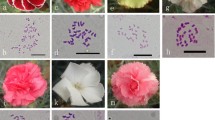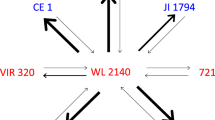Summary
1. Continuous back-crossing of theN. rustica (24II)-paniculata (12II) hybrid toN. paniculata has resulted in a series of true breeding derivative types quite distinct frompaniculata but having the same chromosome number (12II).
2. Although the two species differ quantitatively and theF 1 is intermediate in character expression, these derivatives behave as Mendelian units when crossed toN. paniculata.
Twelve types have so far been analysed and proved to be simple recessives, two of them being allelomorphic. One very distinctive derivative in which the corolla is spurred has been shown to be due to the interaction of four recessive factors.
3. The characters differentiating these types fromN. paniculata are not present as visible character contrasts in the two parental species.
4. The suggestion is made that the chromosomes ofN. rustica which pair with those ofN. paniculata are partially non-homologous as regards the serial arrangement of the chromomeres. Crossing-over would then often result in deficiency-duplication gametes. SinceN. paniculata is a basic diploid species only the smaller deficiencies and gene interchanges are viable, and accordingly most derivatives are recessives. Some types are no doubt the expression ofrustica genes interacting with an otherwise normalpaniculata complex.
5. It is also suggested thatF 1 hybrid sterility is largely due to the production of inviable gametes by the above type of non-homologous crossing-over.
Similar content being viewed by others
References
East, E. M. (1921). “A study of partial sterility in certain hybrids.”Genetics,6, 311–65.
Lammerts, W. E. (1929). “Interspecific hybridization inNicotiana. IX. Further studies of the cytology of the back-cross progenies of thepaniculata-rustica hybrid.” Ibid.14, 286–304.
-- (1934). “Derivative types obtained by back-crossingN. rustica-paniculata toN. rustica.” (In press.)
McClintock, Barbara (1933). “The association of non-homologous parts of chromosomes in the mid-prophase of meiosis inZea Mays.”Zeit. für Zellfor. u. Mikr. Anat. 19, 191–237.
Watkins, A. E. andCory, F. M. (1931). “Genetic and cytological studies in wheat. V.”Journ. Gen. 25, 55–90.
Author information
Authors and Affiliations
Rights and permissions
About this article
Cite this article
Lammerts, W.E. Derivative types obtained by backcrossingNicotiana Rustica-Paniculata toN. Paniculata . Journ. of Genetics 29, 355–366 (1934). https://doi.org/10.1007/BF02982232
Issue Date:
DOI: https://doi.org/10.1007/BF02982232




